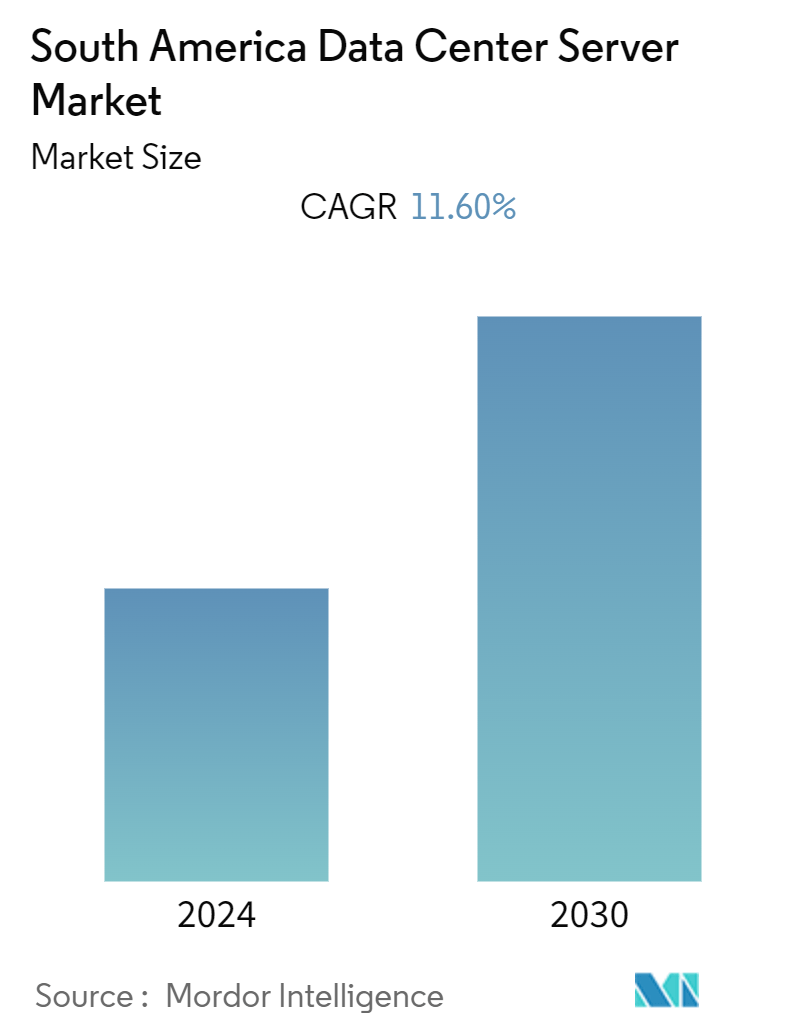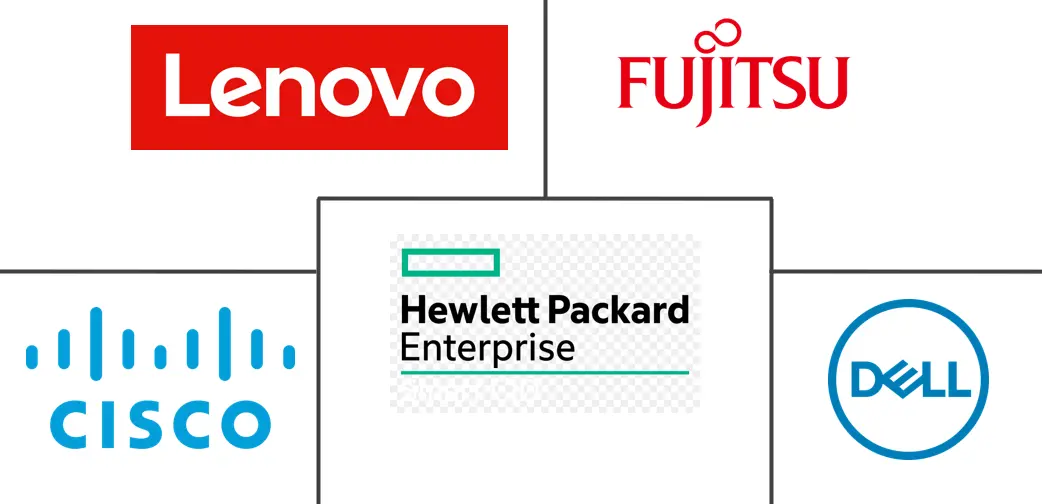Market Size of South America Data Center Server Industry

| Study Period | 2019 - 2030 |
| Base Year For Estimation | 2023 |
| Forecast Data Period | 2024 - 2030 |
| Historical Data Period | 2019 - 2022 |
| CAGR (2024 - 2030) | 11.60 % |
| Market Concentration | Medium |
Major Players
*Disclaimer: Major Players sorted in no particular order |
South America Data Center Server Market Analysis
The South America Data Center Server Market is expected to register a CAGR of 11.60% during the forecast period.
The South America data center server market reached a value of USD 3.2 billion in the previous year, and it is further projected to register a CAGR of 11.6% during the forecast period. The increasing demand for cloud computing among small and medium-sized enterprises (SMEs), government regulations for local data security, and growing investment by domestic players are some of the major factors driving the demand for data centers in the region.
- The upcoming IT load capacity of the South America data center construction market is expected to reach 1800 MW by 2029.
- The region's construction of raised floor area is expected to increase 7.8 million sq. ft by 2029.
- The region's total number of racks to be installed is expected to reach 392K units by 2029. Brazil is expected to house the maximum number of racks by 2029.
- There are close to 60 submarine cable systems connecting South America, and many are under construction. One such submarine cable that is estimated to start service in 2025 is Carnival Submarine Network-1 (CSN-1), which stretches over 4500 Kilometers with a landing point in Barranquilla, Colombia.
South America Data Center Server Industry Segmentation
A data center server is basically a high-capacity computer without peripherals like monitors and keyboards. It is a hardware unit installed inside a rack, having a central processing unit (CPU), storage, and other electrical and networking equipment, making them powerful computers that deliver applications, services, and data to end-user devices.
The South America data center server market is segmented by form factor (blade server, rack server, and tower server), by end-user (IT and telecommunication, BFSI, government, media and entertainment, and other end users), and by geography (Brazil, Chile, and Rest of South America). The market sizes and forecasts are provided in terms of value (USD) for all the above segments.
| Form Factor | |
| Blade Server | |
| Rack Server | |
| Tower Server |
| End-User | |
| IT & Telecommunication | |
| BFSI | |
| Government | |
| Media & Entertainment | |
| Other End-User |
| Geography | |
| Brazil | |
| Chile | |
| Rest of South America |
South America Data Center Server Market Size Summary
The South America data center server market is experiencing significant growth, driven by the increasing demand for cloud computing, particularly among small and medium-sized enterprises, and supportive government regulations for local data security. The region is witnessing substantial investments from domestic players, which are further propelling the market's expansion. Brazil stands out as a major hub, benefiting from government incentives and a burgeoning digital economy characterized by rising internet penetration, digital payments, and e-commerce activities. The construction of new data centers and the expansion of cloud services across countries like Brazil, Chile, Colombia, and Argentina are expected to enhance the region's data center infrastructure, with Brazil anticipated to host the largest number of racks by the end of the forecast period.
The market is moderately consolidated, with key players such as Dell Inc., Hewlett Packard Enterprise, Fujitsu, and Lenovo Group Limited leading the charge in expanding their regional presence. These companies are actively launching next-generation servers and storage systems to meet the growing demand for high-performance storage solutions, driven by the adoption of artificial intelligence and machine learning technologies. The telecom sector is also contributing to the market's growth, with the rollout of 5G networks expected to increase data consumption and, consequently, the need for more data center servers. As the region continues to evolve, with countries like Argentina and Colombia enhancing their cloud computing frameworks, the South America data center server market is poised for robust growth in the coming years.
South America Data Center Server Market Size - Table of Contents
-
1. Market Dynamics
-
1.1 Market Overview
-
1.2 Market Drivers
-
1.2.1 Increasing Adoption of Cloud Technologies
-
1.2.2 Large-scale commercialization of 5G networks
-
-
1.3 Market Restraints
-
1.3.1 Rising CapEx for data center construction
-
1.3.2 Cybersecurity Threats
-
-
1.4 Value Chain / Supply Chain Analysis
-
1.5 Industry Attractiveness - Porter's Five Forces Analysis
-
1.5.1 Threat of New Entrants
-
1.5.2 Bargaining Power of Buyers/Consumers
-
1.5.3 Bargaining Power of Suppliers
-
1.5.4 Threat of Substitute Products
-
1.5.5 Intensity of Competitive Rivalry
-
-
1.6 Assessment of COVID-19 Impact
-
-
2. MARKET SEGMENTATION
-
2.1 Form Factor
-
2.1.1 Blade Server
-
2.1.2 Rack Server
-
2.1.3 Tower Server
-
-
2.2 End-User
-
2.2.1 IT & Telecommunication
-
2.2.2 BFSI
-
2.2.3 Government
-
2.2.4 Media & Entertainment
-
2.2.5 Other End-User
-
-
2.3 Geography
-
2.3.1 Brazil
-
2.3.2 Chile
-
2.3.3 Rest of South America
-
-
South America Data Center Server Market Size FAQs
What is the current South America Data Center Server Market size?
The South America Data Center Server Market is projected to register a CAGR of 11.60% during the forecast period (2024-2030)
Who are the key players in South America Data Center Server Market?
Dell Inc., Hewlett Packard Enterprise, Lenovo Group Limited, Cisco Systems Inc. and IBM Corporation are the major companies operating in the South America Data Center Server Market.

